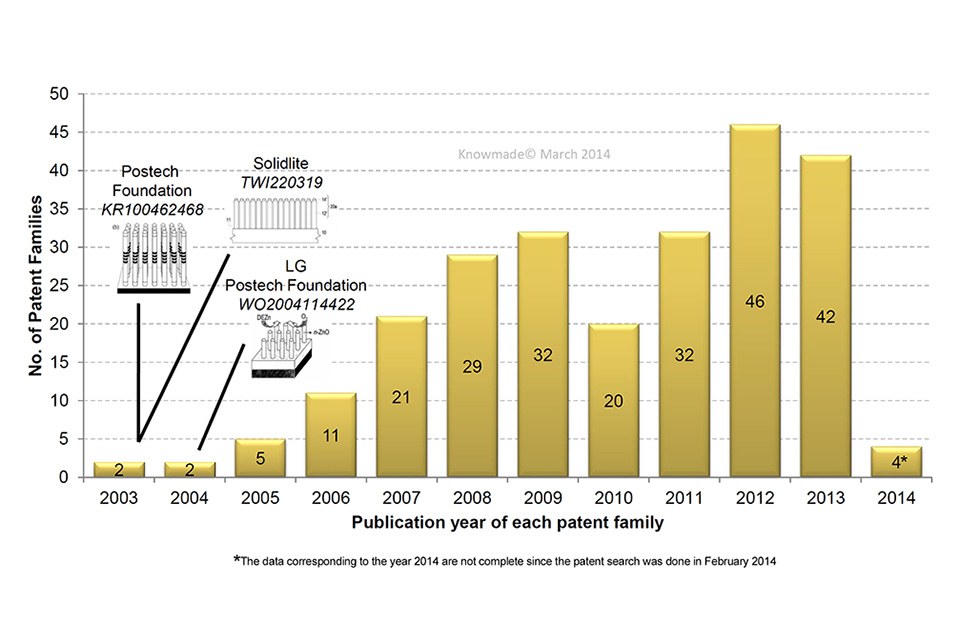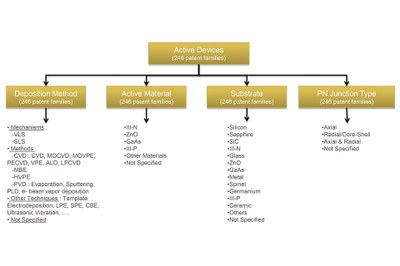Yole Releases New Nanowire LED IP Study - Startups Compete with Asian LED Giants in the IP Landscape
Asian giants Samsung, Panasonic and LG are the top three patent assignees for Nanowire LED technology. Facing them are several startups including glo, Aledia and Ecospark, which between them have raised more than $150M - thus confirming their serious interest in this field. However, these newcomers face strong technological challenges.
Objectives of the report::
• Provide an overview of the LED market and its technology and market trends
• Review the context for Nanowire LED technology
• Identify the proposition value of the Nanowire approach compared to planar LEDs
• Understand the IP landscape for Nanowire LEDs
• Identify key patents by technology make-up or patent assignee
• Understand Nanowire LED IP trends
• Identify the major players in Nanowire LED IP and the relative strength of their patent portfolio
• Identify IP collaboration networks between key players (Samsung, Sharp, LG, Ecospark, Panasonic, Korea Institute etc.).
Nanowire-based LEDs were first reported in the early 2000s by Harvard University (J. American Chemical Soc., 122, 1, 188-189) and National Taiwan Normal University (Adv. Mat., 12, 10, 738). The first patent was filed in 2002 by Postech Foundation for an axial PN junction architecture. Since then, companies have shown growing interest in nanowire-based LED for improved light extraction and thermal conduction.
Fundamental patents describing a nanowire-based axial LED were filed during the 2000s, with the most significant ones coming from Postech Foundation, Solidlite and LG. In the mid-2000s, Philips, Nanosys, LG and Seoul Opto Devices filed the first radial/core-shell nanowire LED patents. Current patented technologies reflect the improvements made in terms of material and junction architecture to achieve limited crystal defects and increased luminous efficiency.
KnowMade’s research covers global patents published through February 2014. Patents addressing the use of nanowires in LED applications have been selected, and an analysis of the patent holders and their patented technologies is provided. This report focuses exclusively on LED and does not include patents related to the fabrication of nanowires for other applications such as solar, detectors, or laser.
Identify key players and discover new IP entrants (I.E Hon Hai precision industry)
More than 100 companies/academics are involved in Nanowire LED IP, and most of the major Nanowire LED players are slightly different from the major LED players. Samsung, LG and Panasonic have strong IP portfolios related to Nanowire LED, but glō, Ecospark, Hon Hai Precision Industry, Nanocrystal, Lextar Electronics and others are strong new entrants to the Nanowire LED IP landscape.
Taking into account their portfolio size, patent citations networks, countries of patents filings and current legal status of patents, this report provides a ranking and relative strength of the top Nanowire LED patent holders. Through thorough analysis we have identified six major players, each of which is profiled in this report. Each profile includes a detailed portfolio summary including patenting activity, patented technologies, key patents, granted patents near expiration, and partnerships.
Refine your patent strategy with a deep patent segmentation and a useful patent database
Through a search strategy consisting of automated and manual screenings, we have been able to identify 300+ patent families. For this report, these families are manually segmented by relevance: patents describing LED applications (relevant patents), and patents describing not only LED applications but also other applications (solar, laser, detector etc.) or devices that use LED nanowires (related patents).
These 300+ patent families are also manually segmented by technology type: “Active Devices”, i.e. when the PN junction is comprised on the nanowire; and “Passive Devices”, i.e. when the nanowire is out of the PN junction (light extraction enhancement). 246 and 116 patent families are related to active and passive devices, respectively.
The dataset is also organized into various technology segments that are analyzed: deposition method, substrate type, active material, passive material and PN junction architecture. III-N and ZnO represent the biggest part of patents related to active and passive devices, respectively. Most patent applicants have filed axial PN junction architecture, but recently they have started turning toward radial PN junction.
More than 30 key patents have been identified based on several indicators, including family size, legal status, citations analysis and impact on Nanowire LED technology.
Our report also includes an Excel database containing all of the analyzed patents. This database allows for multi-criteria searches and includes patent publication number, hyperlinks to the original documents, priority date, title, abstract, patent assignees, technological segments and legal status for each member of the patent family.
Companies cited in the report (non-exhaustive list)
Aledia, CEA, Chonbuk National University, Delta Electronics, Dongguk University, Ecospark, Electronics and Telecommunications Research Institute (ETRI), Epistar, General Electric, glō, Gwangju Institute, Hanyang University, Hewlett Packard, Hokkaido University, Hongfujin Precision Industry, Hon Hai Precision Industry, Industrial Technology Research Institute (ITRI), Inha University, Institute of Semiconductors (CAS), Kodak, Korea Institute, Korean Research Institute of Chemical Technology (KRICT), Kumoh National Institute Technology, Lite-On Technology, Lextar Electronics, LG, Lund University, McGill University, Merck, Nanocrystal, Nanosys, National Chiao Tung University, National Science Foundation, NEC,Nitek, Postech Foundation (Pohang University of Sciences and Technology), Panasonic, Philips, Photonstar LED, QuNano, Rensselaer Polytechnic Institute, Samsung, Seoul Opto Devices, Seoul University, Shandong University, Sharp, Sino American Silicon Products, Solidlite, Sophia School, Stormled, Sundiode, Sungkyunkwan University, Sun Yat Sen University, Suzhou Institute of Nano-Tech and Nano-Bionics (SINANO), Suzhou Nanowin Science and Technology (Nanowin), Tatwah Smartech, Tsinghua University, Ulsan National Institute of Science and Technology (UNIST), University of California...
More information can be found at the Yole Microsite where also a summary of the report can be downloaded and the original report can be ordered.



